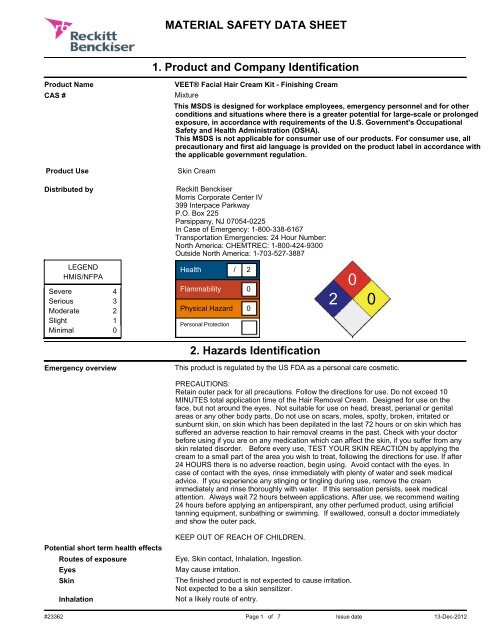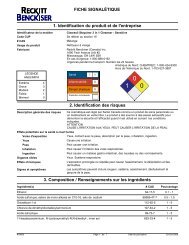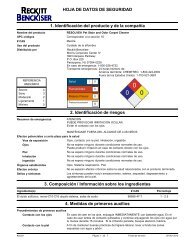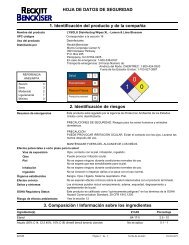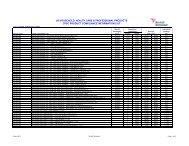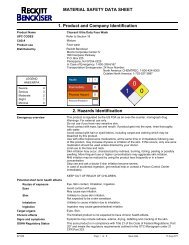MATERIAL SAFETY DATA SHEET 1. Product ... - Reckitt Benckiser
MATERIAL SAFETY DATA SHEET 1. Product ... - Reckitt Benckiser
MATERIAL SAFETY DATA SHEET 1. Product ... - Reckitt Benckiser
Create successful ePaper yourself
Turn your PDF publications into a flip-book with our unique Google optimized e-Paper software.
.<br />
.<br />
<strong>MATERIAL</strong> <strong>SAFETY</strong> <strong>DATA</strong> <strong>SHEET</strong><br />
space<br />
<strong>Product</strong> Name<br />
space<br />
CAS #<br />
space<br />
<strong>1.</strong> <strong>Product</strong> and Company Identification<br />
VEET® Facial Hair Cream Kit - Finishing Cream<br />
Mixture<br />
This MSDS is designed for workplace employees, emergency personnel and for other<br />
conditions and situations where there is a greater potential for large-scale or prolonged<br />
exposure, in accordance with requirements of the U.S. Government's Occupational<br />
Safety and Health Administration (OSHA).<br />
This MSDS is not applicable for consumer use of our products. For consumer use, all<br />
precautionary and first aid language is provided on the product label in accordance with<br />
the applicable government regulation.<br />
<strong>Product</strong> Use<br />
space<br />
Distributed by<br />
space<br />
LEGEND<br />
HMIS/NFPA<br />
Severe<br />
Serious<br />
4<br />
3<br />
Moderate 2<br />
Slight 1<br />
Minimal 0<br />
space<br />
Emergency overview<br />
Skin Cream<br />
<strong>Reckitt</strong> <strong>Benckiser</strong><br />
Morris Corporate Center IV<br />
399 Interpace Parkway<br />
P.O. Box 225<br />
Parsippany, NJ 07054-0225<br />
In Case of Emergency: 1-800-338-6167<br />
Transportation Emergencies: 24 Hour Number:<br />
North America: CHEMTREC: 1-800-424-9300<br />
Outside North America: 1-703-527-3887<br />
Health / 2<br />
Flammability 0<br />
Physical Hazard 0<br />
Personal Protection<br />
2. Hazards Identification<br />
0<br />
2 0<br />
This product is regulated by the US FDA as a personal care cosmetic.<br />
PRECAUTIONS:<br />
Retain outer pack for all precautions. Follow the directions for use. Do not exceed 10<br />
MINUTES total application time of the Hair Removal Cream. Designed for use on the<br />
face, but not around the eyes. Not suitable for use on head, breast, perianal or genital<br />
areas or any other body parts. Do not use on scars, moles, spotty, broken, irritated or<br />
sunburnt skin, on skin which has been depilated in the last 72 hours or on skin which has<br />
suffered an adverse reaction to hair removal creams in the past. Check with your doctor<br />
before using if you are on any medication which can affect the skin, if you suffer from any<br />
skin related disorder. Before every use, TEST YOUR SKIN REACTION by applying the<br />
cream to a small part of the area you wish to treat, following the directions for use. If after<br />
24 HOURS there is no adverse reaction, begin using. Avoid contact with the eyes. In<br />
case of contact with the eyes, rinse immediately with plenty of water and seek medical<br />
advice. If you experience any stinging or tingling during use, remove the cream<br />
immediately and rinse thoroughly with water. If this sensation persists, seek medical<br />
attention. Always wait 72 hours between applications. After use, we recommend waiting<br />
24 hours before applying an antiperspirant, any other perfumed product, using artificial<br />
tanning equipment, sunbathing or swimming. If swallowed, consult a doctor immediately<br />
and show the outer pack.<br />
space<br />
Potential short term health effects<br />
Routes of exposure<br />
space<br />
Eyes<br />
space<br />
Skin<br />
space<br />
Inhalation<br />
KEEP OUT OF REACH OF CHILDREN.<br />
Eye, Skin contact, Inhalation, Ingestion.<br />
May cause irritation.<br />
The finished product is not expected to cause irritation.<br />
Not expected to be a skin sensitizer.<br />
Not a likely route of entry.<br />
#23362 Page 1 of 7 Issue date 13-Dec-2012
.<br />
.<br />
.<br />
.<br />
space<br />
Ingestion<br />
space<br />
Target organs<br />
space<br />
Chronic effects<br />
space<br />
Signs and symptoms<br />
space<br />
OSHA Regulatory Status<br />
space<br />
Potential environmental effects See section 12.<br />
Ingestion may cause gastrointestinal irritation.<br />
Eyes. Kidney. Respiratory system. Skin.<br />
The finished product is not expected to have chronic health effects.<br />
Symptoms may include redness, edema, drying, defatting and cracking of the skin.<br />
This product is a "Hazardous Chemical" as defined by the OSHA Hazard Communication<br />
Standard, 29 CFR 1910.1200.<br />
3. Composition / Information on Ingredients<br />
space<br />
Ingredient(s) CAS # Percent<br />
Isopropyl Palmitate<br />
Disodium Phosphate<br />
Phenoxyethanol<br />
142-91-6<br />
7558-79-4<br />
122-99-6<br />
2.5 - 10<br />
1 - 2.5<br />
0.1 - 1<br />
4. First Aid Measures<br />
space<br />
First aid procedures<br />
Eye contact<br />
space<br />
Avoid contact with eyes. In case of contact with eyes, rinse immediately with plenty of<br />
water and seek medical advice.<br />
Skin contact Discontinue use if irritation and redness develop. If condition persists for more than 72<br />
hours, consult a physician.<br />
In case of accidental and excess application of the product, rinse with water.<br />
space<br />
Inhalation<br />
Not an anticipated route of exposure. Move victim to fresh air. If symptoms persist,<br />
obtain medical attention.<br />
space<br />
Ingestion<br />
If swallowed, consult a doctor immediately and show the outer pack. Do not induce<br />
vomiting. Immediately rinse mouth out with water.<br />
space<br />
Notes to physician<br />
Treat patient symptomatically.<br />
space<br />
General advice<br />
space<br />
Flammable properties<br />
space<br />
Extinguishing media<br />
space<br />
Suitable extinguishing media<br />
Unsuitable extinguishing media Not available<br />
space<br />
Protection of firefighters<br />
Specific hazards arising from Not available.<br />
the chemical<br />
space<br />
Protective equipment for<br />
firefighters<br />
space<br />
Hazardous combustion products<br />
space<br />
Explosion data<br />
space<br />
Sensitivity to mechanical impact Not available<br />
Sensitivity to static discharge<br />
space<br />
Personal precautions<br />
space<br />
Environmental precautions<br />
space<br />
Methods for containment<br />
If you feel unwell, seek medical advice (show the label where possible). Ensure that<br />
medical personnel are aware of the material(s) involved, and take precautions to protect<br />
themselves. Show this safety data sheet to the doctor in attendance. Avoid contact with<br />
eyes. Keep out of reach of children.<br />
5. Fire Fighting Measures<br />
Not flammable by OSHA criteria.<br />
Water spray. Foam. Carbon dioxide. Dry chemical.<br />
Firefighters should wear full protective clothing including self contained breathing<br />
apparatus.<br />
May include and are not limited to: Oxides of carbon. Oxides of nitrogen. Oxides of sulfur.<br />
Not available<br />
6. Accidental Release Measures<br />
Keep unnecessary personnel away. Do not touch or walk through spilled material. Do not<br />
touch damaged containers or spilled material unless wearing appropriate protective<br />
clothing. Keep people away from and upwind of spill/leak. Floors may become slippery.<br />
Do not discharge into lakes, streams, ponds or public waters.<br />
Advise authorities if product has penetrated drains, sewers or water pipes.<br />
Stop leak if you can do so without risk. Prevent entry into waterways, sewers, basements<br />
or confined areas.<br />
#23362 Page 2 of 7 Issue date 13-Dec-2012
.<br />
.<br />
.<br />
space<br />
Methods for cleaning up<br />
space<br />
Handling<br />
space<br />
Storage<br />
Before attempting clean up, refer to hazard data given above. Small spills may be<br />
absorbed with non-reactive absorbent and placed in suitable, covered, labelled<br />
containers. Prevent large spills from entering sewers or waterways. Contact emergency<br />
services and supplier for advice.<br />
7. Handling and Storage<br />
Avoid contact with eyes.<br />
Use good industrial hygiene practices in handling this material.<br />
Avoid spillage on carpets, clothes and flooring.<br />
Use according to package label instructions.<br />
Keep out of reach of children.<br />
Store in a closed container away from incompatible materials.<br />
Do not store contents under direct sunlight.<br />
Store at 5-25°C.<br />
Do not expose to temperatures exceeding 40°C.<br />
Keep from freezing.<br />
Excursions:<br />
60°C - Not permitted.<br />
50°C - Not more than 4 weeks.<br />
40°C - Not more than 8 weeks.<br />
space<br />
Exposure limits<br />
Ingredient(s)<br />
Disodium Phosphate<br />
Isopropyl Palmitate<br />
Do not store below -20°C.<br />
8. Exposure Controls / Personal Protection<br />
Exposure Limits<br />
ACGIH-TLV<br />
Not established<br />
OSHA-PEL<br />
Not established<br />
ACGIH-TLV<br />
Not established<br />
OSHA-PEL<br />
Not established<br />
Phenoxyethanol<br />
space<br />
Engineering controls<br />
space<br />
Personal protective equipment<br />
ACGIH-TLV<br />
Not established<br />
OSHA-PEL<br />
Not established<br />
General ventilation normally adequate.<br />
Consult the product label for special protection or precautions that have been identified<br />
for using this product under directed consumer use conditions. The following<br />
recommendations are given for workplace employees, emergency personnel and for<br />
other conditions and situations where there is a greater potential for large-scale or<br />
prolonged exposure.<br />
space<br />
space<br />
space<br />
space<br />
Eye / face protection<br />
Follow standard industrial hygiene practices.<br />
Hand protection<br />
Not required.<br />
Skin and body protection Not normally required.<br />
Respiratory protection<br />
Where exposure guideline levels may be exceeded, use an approved NIOSH respirator.<br />
General hygiene considerations Handle in accordance with good industrial hygiene and safety practice.<br />
When using do not eat or drink.<br />
Wash hands before breaks and immediately after handling the product.<br />
9. Physical and Chemical Properties<br />
space<br />
Appearance<br />
space<br />
Color<br />
Cream.<br />
White.<br />
#23362 Page 3 of 7 Issue date 13-Dec-2012
.<br />
.<br />
space<br />
Form<br />
Cream<br />
space<br />
Odor<br />
Fragrant<br />
space<br />
Odor threshold<br />
Not available<br />
space<br />
Physical state<br />
Liquid<br />
space<br />
pH 6.5 - 7.5<br />
space<br />
Freezing point<br />
space<br />
Boiling point<br />
space<br />
Pour point<br />
space<br />
Evaporation rate<br />
space<br />
Flash point<br />
space<br />
Auto-ignition temperature<br />
space<br />
Flammability limits in air, lower, %<br />
by volume<br />
space<br />
Flammability limits in air, upper, %<br />
by volume<br />
space<br />
Vapor pressure<br />
space<br />
Vapor density<br />
space<br />
Specific gravity<br />
space<br />
Octanol/water coefficient<br />
space<br />
VOC (Weight %)<br />
space<br />
Percent volatile<br />
Not available<br />
Not available<br />
Not available<br />
Not available<br />
Not available<br />
Not available<br />
Not available<br />
Not available<br />
Not available<br />
Not available<br />
Not available<br />
Not available<br />
Not available<br />
Not available<br />
10. Stability and Reactivity<br />
space<br />
Reactivity<br />
space<br />
Possibility of hazardous reactions<br />
space<br />
Chemical stability<br />
space<br />
Conditions to avoid<br />
space<br />
Incompatible materials<br />
This product may react with strong acids.<br />
Hazardous polymerization does not occur.<br />
Stable under recommended storage conditions.<br />
Reacts violently with acids.<br />
This product may react with oxidizing agents.<br />
Do not mix with other chemicals.<br />
Temperatures below 5°C and >40°C.<br />
Keep from freezing.<br />
Acids. Oxidizing agents.<br />
space<br />
Hazardous decomposition products May include and are not limited to: Oxides of carbon. Oxides of nitrogen. Oxides of sulfur.<br />
space<br />
Component analysis - LC50<br />
Ingredient(s)<br />
1<strong>1.</strong> Toxicological Information<br />
LC50<br />
Disodium Phosphate<br />
Isopropyl Palmitate<br />
Phenoxyethanol<br />
space<br />
Component analysis - Oral LD50<br />
Ingredient(s)<br />
Disodium Phosphate<br />
Isopropyl Palmitate<br />
Phenoxyethanol<br />
space<br />
Effects of acute exposure<br />
space<br />
space<br />
Eye<br />
Skin<br />
Inhalation<br />
space<br />
Ingestion<br />
space<br />
Sensitization<br />
space<br />
Chronic effects<br />
May cause irritation.<br />
Not available<br />
Not available<br />
Not available<br />
LD50<br />
17000 mg/kg rat<br />
5000 mg/kg rat<br />
1260 mg/kg rat<br />
The finished product is not expected to cause irritation.<br />
Not expected to be a skin sensitizer.<br />
Not a likely route of entry.<br />
Ingestion may cause gastrointestinal irritation.<br />
The finished product is not expected to have chronic health effects.<br />
The finished product is not expected to have chronic health effects.<br />
#23362 Page 4 of 7 Issue date 13-Dec-2012
.<br />
.<br />
.<br />
space<br />
Carcinogenicity<br />
The finished product is not expected to have chronic health effects.<br />
space<br />
Mutagenicity<br />
The finished product is not expected to have chronic health effects.<br />
space<br />
Reproductive effects<br />
The finished product is not expected to have chronic health effects.<br />
space<br />
Teratogenicity<br />
The finished product is not expected to have chronic health effects.<br />
space<br />
Name of Toxicologically Synergistic Not available<br />
<strong>Product</strong>s<br />
space<br />
Ecotoxicity<br />
12. Ecological Information<br />
Components of this product have been identified as having potential environmental<br />
concerns.<br />
Ecotoxicity - Freshwater Algae - Acute Toxicity Data<br />
Phenoxyethanol 122-99-6 72 Hr EC50 Desmodesmus subspicatus: >500 mg/L<br />
Ecotoxicity - Freshwater Fish - Acute Toxicity Data<br />
Phenoxyethanol 122-99-6 96 Hr LC50 Pimephales promelas: 337-352 mg/L [flow-through]; 96 Hr LC50<br />
Pimephales promelas: 366 mg/L [static]; 96 Hr LC50 Leuciscus idus: 220-460 mg/L<br />
[static]<br />
Ecotoxicity - Water Flea - Acute Toxicity Data<br />
Phenoxyethanol 122-99-6 48 Hr EC50 Daphnia magna: >500 mg/L<br />
space<br />
Persistence / degradability<br />
Not available<br />
space<br />
Bioaccumulation / accumulation Not available<br />
space<br />
Mobility in environmental media Not available<br />
space<br />
Environmental effects<br />
Not available<br />
space<br />
Aquatic toxicity<br />
Not available<br />
space<br />
Partition coefficient<br />
Not available<br />
space<br />
Chemical fate information<br />
Not available<br />
space<br />
Disposal instructions<br />
space<br />
Waste from residues / unused<br />
products<br />
space<br />
Contaminated packaging<br />
13. Disposal Considerations<br />
Dispose in accordance with all applicable regulations.<br />
Dispose of empty packaging with normal household trash.<br />
Not available<br />
Not available<br />
14. Transport Information<br />
space<br />
UN/ID N.o.<br />
Not applicable<br />
U.S. Department of Transportation (DOT): Classification: Not regulated<br />
Proper shipping name Not applicable<br />
U.S. DOT Hazard Class<br />
Subsidiary Risk<br />
Packing group<br />
DOT RQ (lbs)<br />
ERG NO<br />
Not applicable<br />
Not applicable<br />
Not applicable<br />
Not applicable<br />
Not applicable<br />
#23362 Page 5 of 7 Issue date 13-Dec-2012
.<br />
.<br />
Transportation of Dangerous Goods (TDG - Canada): Classification: Not regulated<br />
Proper shipping name Not applicable<br />
Status<br />
Packing group<br />
Not applicable<br />
Not applicable<br />
IMDG (Marine Transport): Classification: Not regulated<br />
Proper shipping name Not applicable<br />
Class<br />
Subsidiary Risk<br />
Packing group<br />
IMDG Page<br />
Marine pollutant<br />
EMS<br />
MFAG<br />
Maximum Quantity<br />
Not applicable<br />
Not applicable<br />
Not applicable<br />
Not applicable<br />
Not applicable<br />
Not applicable<br />
Not applicable<br />
Not applicable<br />
IATA/ICAO (Air): Classification: Not regulated<br />
Proper shipping name<br />
Not applicable<br />
Class<br />
Subsidiary Risk:<br />
Packing group<br />
Maximum Quantity<br />
Not applicable<br />
Not applicable<br />
Not applicable<br />
Not applicable<br />
15. Regulatory Information<br />
space<br />
Occupational Safety and Health Administration (OSHA)<br />
29 CFR 1910.1200 hazardous<br />
chemical<br />
Yes<br />
#23362 Page 6 of 7 Issue date 13-Dec-2012
.<br />
.<br />
US Federal regulations<br />
This cosmetic product is in compliance with Title 21 of the Code of Federal Regulations,<br />
Part 701 and 740.<br />
All components of this product are either on the TSCA Inventory, or are exempt from<br />
TSCA Inventory.<br />
U.S. - CAA (Clean Air Act) - HON Rule - SOCMI Chemicals<br />
Phenoxyethanol 122-99-6 Group I<br />
U.S. - CAA (Clean Air Act) - Reactivity Factors for VOCs in Aerosol Coatings<br />
Phenoxyethanol 122-99-6 3.61 G Ozone/g VOC Reactivity Factor<br />
U.S. - CAA (Clean Air Act) - Volatile Organic Compounds (VOCs) in SOCMI<br />
Phenoxyethanol 122-99-6 Present<br />
U.S. - CERCLA/SARA - Hazardous Substances and their Reportable Quantities<br />
Disodium Phosphate 7558-79-4 5000 Lb final RQ; 2270 kg final RQ<br />
U.S. - CWA (Clean Water Act) - Hazardous Substances<br />
Disodium Phosphate 7558-79-4 Present<br />
space<br />
CERCLA (Superfund) reportable quantity<br />
Sodium phosphate dibasic: 5000.0000<br />
space<br />
Superfund Amendments and Reauthorization Act of 1986 (SARA)<br />
space<br />
space<br />
Hazard categories<br />
Section 302 extremely<br />
hazardous substance<br />
Immediate Hazard - Yes<br />
Delayed Hazard - No<br />
Fire Hazard - No<br />
Pressure Hazard - No<br />
Reactivity Hazard - No<br />
No<br />
space<br />
Section 311 hazardous chemical Yes<br />
space<br />
Clean Water Act (CWA)<br />
Hazardous substance<br />
space<br />
State regulations This product is not subject to warning labeling under the California Proposition 65<br />
regulation.<br />
U.S. - California - 8 CCR Section 339 - Director's List of Hazardous Substances<br />
Disodium Phosphate 7558-79-4 Present<br />
U.S. - Louisiana - Reportable Quantity List for Pollutants<br />
Disodium Phosphate 7558-79-4 5000 Lb final RQ; 2270 kg final RQ<br />
U.S. - Massachusetts - Right To Know List<br />
Disodium Phosphate 7558-79-4 Present<br />
U.S. - New Jersey - Right to Know Hazardous Substance List<br />
Disodium Phosphate 7558-79-4 sn 1723<br />
U.S. - New York - Reporting of Releases Part 597 - List of Hazardous Substances<br />
Disodium Phosphate 7558-79-4 5000 Lb RQ (air); 100 lb RQ (land/water)<br />
U.S. - Pennsylvania - RTK (Right to Know) List<br />
Disodium Phosphate 7558-79-4 Environmental hazard<br />
Inventory status<br />
Country(s) or region Inventory name On inventory (yes/no)*<br />
United States & Puerto Rico Toxic Substances Control Act (TSCA) Inventory No<br />
A "Yes" indicates that all components of this product comply with the inventory requirements administered by the governing country(s)<br />
space<br />
Disclaimer<br />
16. Other Information<br />
This product should only be used as directed on the label and for the purpose intended.<br />
To the best of our knowledge, the information contained herein is accurate. However,<br />
neither the above named supplier nor any of its subsidiaries assumes any liability<br />
whatsoever for the accuracy or completeness of the information contained herein. Final<br />
determination of suitability of any material is the sole responsibility of the user. All<br />
materials may present unknown hazards and should be used with caution. Although<br />
certain hazards are described herein, we cannot guarantee that these are the only<br />
hazards that exist.<br />
space<br />
Further information VEET® Facial Hair Cream Kit - Finishing Cream, <strong>1.</strong>69 fl oz - 8024392v<strong>1.</strong>0<br />
space<br />
Issue date<br />
13-Dec-2012<br />
space<br />
Effective date<br />
15-Dec-2012<br />
space<br />
Prepared by <strong>Reckitt</strong> <strong>Benckiser</strong> Regulatory Department 800-333-3899<br />
space<br />
Other information<br />
For an updated MSDS, please contact the supplier/manufacturer listed on the first<br />
page of the document.<br />
#23362 Page 7 of 7 Issue date 13-Dec-2012


